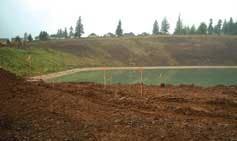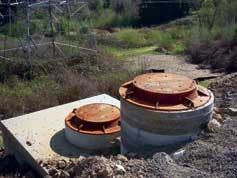Filtration System Maximizes Land Space
By Rex Hansen
Construction of a 110-acre mixed-use development in Beaverton, OR, is now underway. Designed around a reclaimed rock quarry on the border between Beaverton and Tigard, OR, the development will include 746 high-density residential units, a commercial town center, 43 acres of parkland, and at its center, an 11-acre lake stocked with fish from the US Fish and Wildlife Service.
In the city of Beaverton, on-site detention of stormwater runoff is typically required to control the volume of runoff sent to downstream channels. This protects the channels from scouring and reduces the potential for flooding. Additionally, under EPA permit regulations, a certain level of water quality must be achieved before runoff is discharged to downstream waterways.
Traditionally, at a development like Progress Ridge, large aboveground detention ponds would be constructed to meet flow control requirements for site stormwater. However, due to the size of the development, a detention pond would have required use of land otherwise available for 200-300 residential units.
"By the time you start adding detention facilities to the available land on the site that is otherwise suitable for building, you make the cost of development much more expensive," said Gary Brentano, Operations Director for the City of Beaverton.
Alternatives considered for the development that offered both flow control and water quality improvement included providing detention facilities with corresponding water quality structures at different locations on site, or installing individual water quality manholes to provide settling before directing runoff to a larger on-site collection facility. Similar to the issue with the aboveground detention ponds, both alternatives would reduce the amount of land available for development.
After reviewing the options, the city agreed with the developer, Polygon Northwest, Vancouver, WA, that a different approach was appropriate. Polygon then proposed to install a series of underground filtration systems manufactured by Stormwater Management, Inc., Portland, OR, to meet detention and water quality requirements, while maximizing the buildable land area. The city is currently using these systems successfully on several other projects.
"We finally decided that this development might not happen at all if we didn't find a way to accommodate some form of stormwater management that didn't include aboveground detention using valuable land on the site," Brentano said. "You hit a point where a developer can't generate enough return on investment to make the investment to begin with. That's in part what led us to consider the StormFilter."
The Stormwater Management StormFilter® is a passive filtration system consisting of an underground concrete structure that houses rechargeable, media-filled filter cartridges with an integrated surface-cleaning function. The system works by passing polluted stormwater runoff through filter cartridges customized to remove site-specific pollutants such as sediments, nutrients, organic compounds and metals.
Available with H-20 load rated manhole lids, the system can be installed in a traffic area or directly under a parking space. The manhole lids provide access for inspections and maintenance. Each filter cartridge's integrated surface-cleaning function helps to maintain the permeability of the filter surface and enhances the overall performance and longevity of the system.
System Installation
Five filtration systems are being installed at Progress Ridge, containing a total of 144 cartridges. Two high-flow bypass structures are also being installed to direct any flows that exceed the design water quality flow rate away from the treatment structures and prevent potential re-suspension of collected pollutants. The largest system being installed is Stormwater Management's Panel Vault StormFilter that contains, on its own, 111 cartridges. The 36'-6'' x 11'-6'' Panel Vault StormFilter and a 6' x 12' StormFilter with 14 cartridges have been installed along side the lake to treat runoff from the development and from SW Barrows Road, a major street that defines the boundary between the two cities.
Runoff from the site and Barrows Road first flows into an underground vault that collects trash and debris before being directed to the panel vault for treatment. In cases where the flow exceeds the design of the panel vault, excess water flows into the 6' x 12' vault. Treated runoff is discharged directly to the lake. The 80-million-gallon lake, which fills the quarry's gravel pit, will be fed in winter by stormwater runoff from the surrounding land, and in summer, it will be supplemented by the city's domestic water supply. The three remaining filtration units are being installed in the residential portion of the development to treat roadway runoff.
"I think from a development perspective, this solution offers a whole host of benefits, including unifying the outfall to the lake in one location and doing so with some fairly high water quality," said Brentano.
All systems will have cartridges configured with two layers of media that include perlite (outer layer), and a zeolite–granular activated carbon (GAC) mix (inner layer). The media, known as ZPG, offers physical filtration of sediment and oil and grease (perlite); metals removal by surface area contact and cation exchange (zeolite); and removal of organic compounds through direct surface adsorption (GAC).
About the Author:
Rex Hansen, P.E., is Director of Sales and Marketing at Stormwater Management, Inc., Portland, OR, where he leads a team of technical sales and marketing professionals. Hansen has extensive experience in the sales and marketing of manufactured water management products. He holds an M.B.A from the University of La Verne and a B.S. in Applied Mechanical Engineering from the University of California, San Diego



